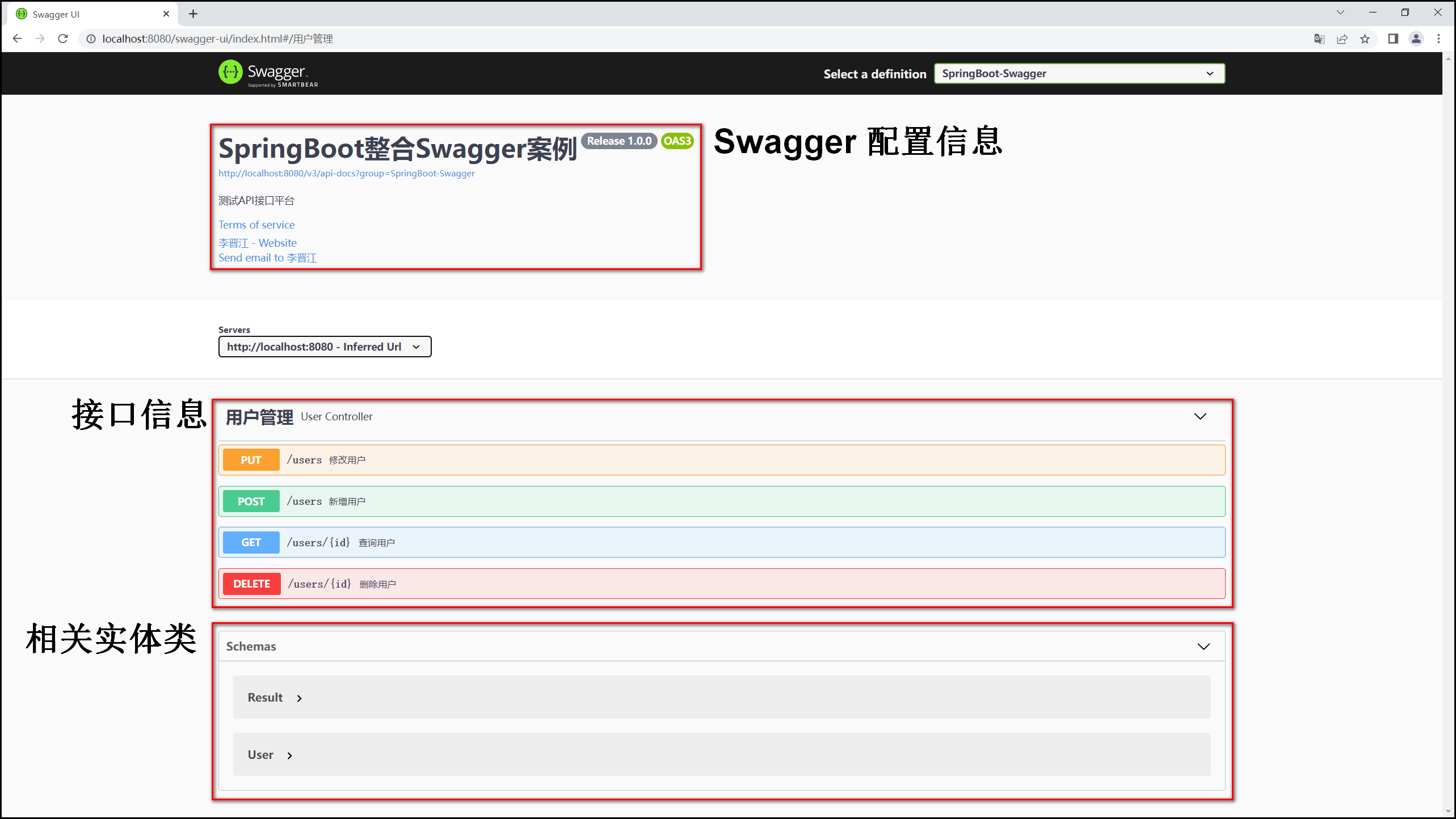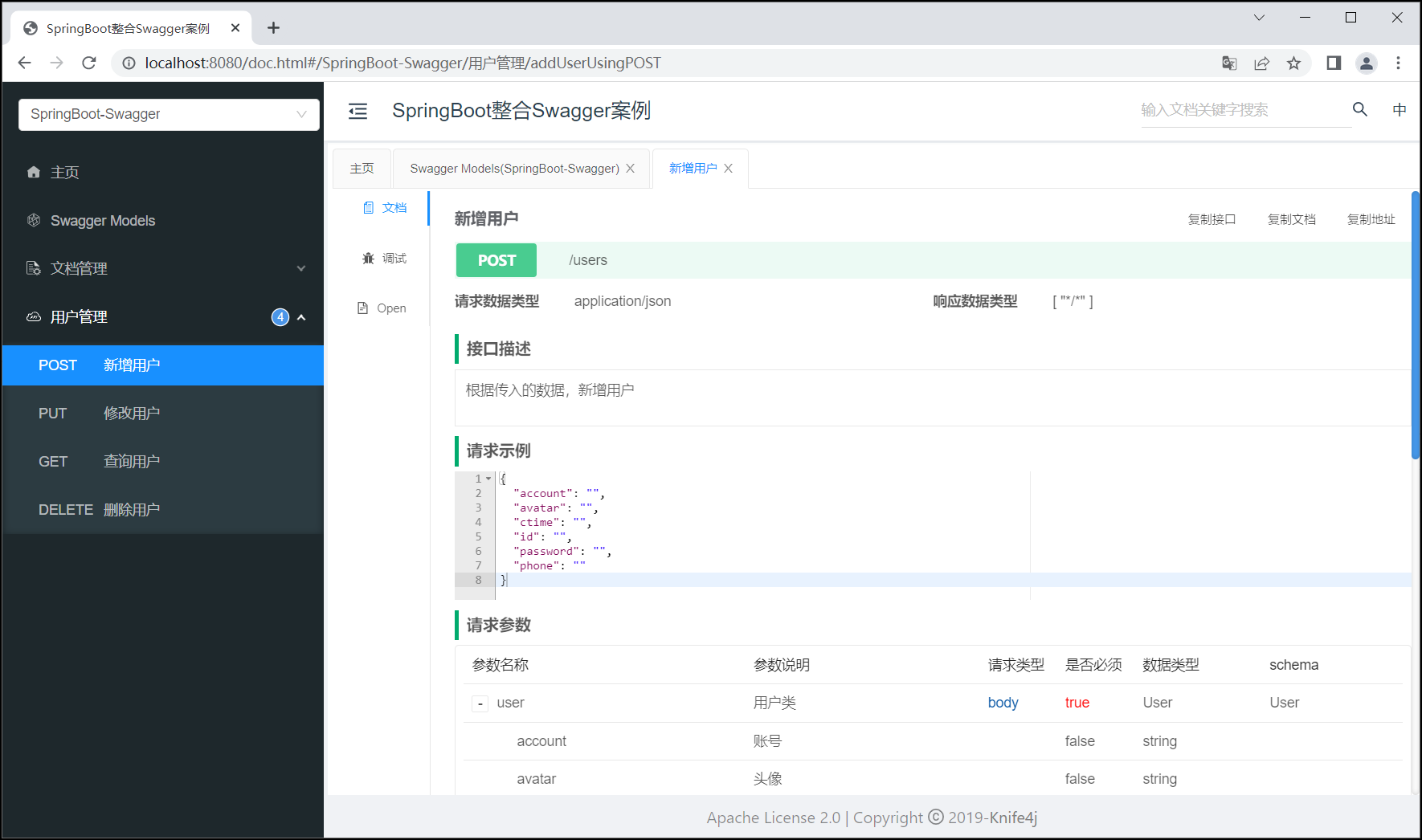【项目管理】SpringBoot2 整合 Swagger3、Knife4j
系统:Win10
JDK:1.8.0_333
IDEA:2022.2.4
SpringBoot:2.7.6
1.项目新建
首先我们先简单搭建一个简单的 SpringBoot 项目,如果之前没有创建过 SpringBoot 项目,可以参考我之前写的一篇创建 SpringBoot 项目的文章:使用IDEA创建SpringBoot项目

2.导入依赖
我们需要使用 Swagger3,需要导入对应依赖,因为 Swagger3 当前只有一个版本,所以版本也不用选了,直接使用 3.0.0 的版本
<?xml version="1.0" encoding="UTF-8"?>
<project xmlns="http://maven.apache.org/POM/4.0.0" xmlns:xsi="http://www.w3.org/2001/XMLSchema-instance"
xsi:schemaLocation="http://maven.apache.org/POM/4.0.0 https://maven.apache.org/xsd/maven-4.0.0.xsd">
<modelVersion>4.0.0</modelVersion>
<parent>
<groupId>org.springframework.boot</groupId>
<artifactId>spring-boot-starter-parent</artifactId>
<version>2.7.6</version>
<relativePath/> <!-- lookup parent from repository -->
</parent>
<groupId>com.lijinjiang</groupId>
<artifactId>SpringBootSwagger</artifactId>
<version>1.0.0</version>
<name>SpringBootSwagger</name>
<description>SpringBootSwagger</description>
<properties>
<!-- JDK 版本 -->
<java.version>1.8</java.version>
<!-- Lombok 版本 -->
<lombok.version>1.18.24</lombok.version>
<!-- Swagger 版本 -->
<swagger.version>3.0.0</swagger.version>
</properties>
<dependencies>
<!-- Lombok -->
<dependency>
<groupId>org.projectlombok</groupId>
<artifactId>lombok</artifactId>
<version>${
lombok.version}</version>
<scope>provided</scope>
</dependency>
<!--Swagger-->
<dependency>
<groupId>io.springfox</groupId>
<artifactId>springfox-boot-starter</artifactId>
<version>${
swagger.version}</version>
</dependency>
<!-- 配置元数据 -->
<dependency>
<groupId>org.springframework.boot</groupId>
<artifactId>spring-boot-configuration-processor</artifactId>
<optional>true</optional>
</dependency>
<dependency>
<groupId>org.springframework.boot</groupId>
<artifactId>spring-boot-starter-web</artifactId>
</dependency>
<dependency>
<groupId>org.springframework.boot</groupId>
<artifactId>spring-boot-starter-test</artifactId>
<scope>test</scope>
</dependency>
</dependencies>
<build>
<plugins>
<plugin>
<groupId>org.apache.maven.plugins</groupId>
<artifactId>maven-compiler-plugin</artifactId>
<version>3.8.1</version>
<configuration>
<source>1.8</source>
<target>1.8</target>
<encoding>UTF-8</encoding>
</configuration>
</plugin>
<plugin>
<groupId>org.springframework.boot</groupId>
<artifactId>spring-boot-maven-plugin</artifactId>
<version>2.7.6</version>
</plugin>
</plugins>
</build>
</project>
3.yml配置
我们将 application.properties 的后缀名改为 yml,并创建对应测试环境的:application-test.yml,并将其中的配置信息完善,这里我们将 Swagger 的配置信息配置到 application-test.yml 中,如果使用的 SpringBoot 版本大于等于 2.6.0,则需要配置路径匹配规则,否则会报错
application.yml
# Tomcat配置
server:
# 端口
port: 8080
# Spring配置
spring:
application:
# 应用名称
name: SpringBootSwagger
# 配置文件
profiles:
# 运行环境
active: test
# 路径匹配机制
mvc:
pathmatch:
matching-strategy: ANT_PATH_MATCHER
application-test.yml
# Document配置信息
swagger:
# 文档标题
title: SpringBoot整合Swagger案例
# 组织信息
group-name: SpringBoot-Swagger
# 是否开启
enable: true
# 描述信息
describe: 测试API接口平台
# 版本信息
version: Release 1.0.0
# 扫包路径
scan-package: com.lijinjiang.swagger.controller
# 组织信息
terms-of-service-url: https://gitee.com/lijinjiang01
# 联系人作者
contact-name: 李晋江
# 链接
contact-url: https://lijinjiang.blog.csdn.net
# 邮箱
contact-email: lijinjiang01@126.com
4.Swagger配置类
在 java 目录下新建 com.lijinjiang.swagger.config.property 包,创建对应的 Swagger 属性配置实体类 SwaggerProperty
import lombok.Data;
import org.springframework.boot.context.properties.ConfigurationProperties;
/**
* @Description Swagger接口文档配置类
* @Author 03010430
* @ModifyDate 2023/2/13 14:36
*/
@Data
@ConfigurationProperties("swagger")
public class SwaggerProperty {
//系统标题
private String title;
//分组名称
private String groupName;
//是否开启
private Boolean enable = true;
//描述信息
private String describe;
//版本信息
private String version;
//扫描路径
private String scanPackage;
//组织链接
private String termsOfServiceUrl;
//联系人名称
private String contactName;
//联系人url
private String contactUrl;
//联系人email
private String contactEmail;
}
在 com.lijinjiang.swagger.config 包下创建 Swagger 的配置类 SwaggerConfig
import com.lijinjiang.swagger.config.property.SwaggerProperty;
import org.springframework.boot.context.properties.EnableConfigurationProperties;
import org.springframework.context.annotation.Bean;
import org.springframework.context.annotation.Configuration;
import springfox.documentation.builders.ApiInfoBuilder;
import springfox.documentation.builders.RequestHandlerSelectors;
import springfox.documentation.service.ApiInfo;
import springfox.documentation.service.Contact;
import springfox.documentation.spi.DocumentationType;
import springfox.documentation.spring.web.plugins.Docket;
import javax.annotation.Resource;
import java.sql.Timestamp;
import java.util.Date;
/**
* @Description Swagger配置文件
* @Author 03010430
* @ModifyDate 2023/2/13 14:35
*/
@Configuration
@EnableConfigurationProperties(SwaggerProperty.class)
public class SwaggerConfig {
@Resource
private SwaggerProperty swaggerProperty;
@Bean
public Docket createApiDoc() {
return new Docket(DocumentationType.OAS_30)
.apiInfo(apiInfo())
.groupName(swaggerProperty.getGroupName())
.enable(swaggerProperty.getEnable())
.select()
.apis(RequestHandlerSelectors.basePackage(swaggerProperty.getScanPackage()))
.build().directModelSubstitute(Timestamp.class, Date.class);
}
private ApiInfo apiInfo() {
return new ApiInfoBuilder()
.title(swaggerProperty.getTitle())
.description(swaggerProperty.getDescribe())
.version(swaggerProperty.getVersion())
.termsOfServiceUrl(swaggerProperty.getTermsOfServiceUrl())
.contact(new Contact(swaggerProperty.getContactName(), swaggerProperty.getContactUrl()
, swaggerProperty.getContactEmail()))
.build();
}
}
5.模拟案例
这里我们模拟一个用户类的增删改查操作
先创建一个 com.lijinjiang.swagger.entity 包,然后创建对应用户类 User
import io.swagger.annotations.ApiModel;
import io.swagger.annotations.ApiModelProperty;
import lombok.Data;
import java.io.Serializable;
import java.sql.Timestamp;
/**
* @Description 用户类
* @Author 03010430
* @ModifyDate 2023/2/13 14:52
*/
@Data
@ApiModel(description = "用户类")
public class User implements Serializable {
private static final long serialVersionUID = 1L;
@ApiModelProperty(value="主键ID")
private String id;
@ApiModelProperty(value="账号")
private String account;
@ApiModelProperty(value="密码")
private String password;
@ApiModelProperty(value="头像")
private String avatar;
@ApiModelProperty(value="电话")
private String phone;
@ApiModelProperty(value="创建时间")
private Timestamp ctime;
}
然后创建 com.lijinjiang.swagger.controller 包,并创建用户控制类 UserController,并在里面模拟用户的增删改查操作(具体的 Mapper 和 Service 没有写)
import com.lijinjiang.swagger.common.Result;
import com.lijinjiang.swagger.entity.User;
import io.swagger.annotations.Api;
import io.swagger.annotations.ApiOperation;
import org.springframework.web.bind.annotation.*;
/**
* @Description 用户控制器
* @Author 03010430
* @ModifyDate 2023/2/13 14:56
*/
@Api(tags = {
"用户管理"})
@RestController
public class UserController {
@ApiOperation(value = "新增用户", notes = "根据传入的数据,新增用户", produces = "application/json")
@PostMapping("/users")
public Result addUser(@RequestBody User user) {
//具体业务代码
return Result.success(null);
}
@ApiOperation(value = "删除用户", notes = "根据传入的id,删除对应用户")
@DeleteMapping("/users/{id}")
public Result deleteUser(@PathVariable("id") String id) {
//具体业务代码
return Result.success(null);
}
@ApiOperation(value = "修改用户", notes = "根据传入的数据,修改用户")
@PutMapping("/users")
public Result updateUser(@RequestBody User user) {
//具体业务代码
return Result.success(null);
}
@ApiOperation(value = "查询用户", notes = "根据传入的id,查找返回对应用户信息")
@GetMapping("/users/{id}")
public Result queryUser(@PathVariable("id") String id) {
//具体业务代码
return Result.success(null);
}
}
6.项目运行
运行项目启动类(这里我将启动类名称改为了 Application) Application,然后登陆 Swagger 的 UI 界面
http://localhost:8080/swagger-ui/index.html

这里还可以做一些简单的测试,不过操作及显示不太友好,最好引入其他显示 UI
7.引入knife4j
因为 Swagger 的默认 UI 显示的不太友好,根据市场上大家的选择,我最终选择 knife4j 作为 Swagger 的显示 UI
这里对 pom.xml 进行调整,直接将引入的 Swagger 依赖改为引入 knife4j 即可
<!-- Knife4j 版本 -->
<knife4j.version>3.0.3</knife4j.version>
<!-- Knife4j 接口文档 -->
<dependency>
<groupId>com.github.xiaoymin</groupId>
<artifactId>knife4j-spring-boot-starter</artifactId>
<version>${knife4j.version}</version>
</dependency>
在 application-test.yml 上添加 knife4j 开启增强功能
# knife4j配置
knife4j:
# 开启增强配置
enable: true

使用一段时间之后,我发现在这个系统上查看文档和测试接口都比较方便的,当然如果是使用 postman 测试的话,可以直接将上面的 Swagger 接口的 url 链接导入到 postman,一样可以进行测试
8.项目结构
这里附上项目最终结构树,供大家参考
